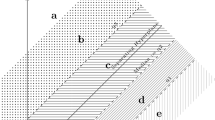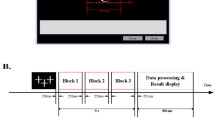Abstract
Brain–computer interfaces can allow users to select letters or other targets on a computer screen without any muscular activity. One of the most popular EEG-based spelling systems is employed with P300 potentials, eliciting the brain's positive electrical response to a flash-denoting gaze at a target character. A P300 spelling system generally uses the row-column paradigm, which displays letters in a matrix and alternately flashes the rows and columns in a randomized order. At the same time, the participant focuses on a target letter. Afterward, a classification algorithm determines the row and column that elicited the largest P300 amplitude and finds the intersection of the identified row and column that indicates the target letter. This paper proposes a probabilistic and 3D column P300 stimulus presentation paradigm for a high-performance spelling system. In contrast to the classical 2D row-column paradigm, we utilized a 3D column stimulus presentation in the proposed paradigm, and we adaptively determined the flashing numbers of columns according to the probability of the following letter in the dictionary between 4 and 13. While the subject-independent P300 speller model was trained with the EEG signals of the first 10 participants, it was independently tested with the second group, including 15 volunteers. The results showed that the proposed probabilistic and 3D column P300 stimulus presentation paradigm-based method achieved 92.69% average classification accuracy, which is 9.94% higher than that of the non-probabilistic 3D column paradigm. The obtained experimental results show the effectiveness and potential of the proposed method to achieve very high performance for brain–computer interface spelling systems.











Similar content being viewed by others
Explore related subjects
Discover the latest articles, news and stories from top researchers in related subjects.Data availability
The datasets created and/or analyzed during the current study were not recorded because of the online analysis and are therefore not publicly available.
References
Ahmad MM, Ahuja, K (2022) Role of 5G communication along with blockchain security in brain-computer interfacing: a review. Futur Design Intell Comput Tech Neurosci Neuroeng, pp 65–85
Aydemir O, Saka K, Ozturk M (2021) Investigating the effects of stimulus duration and inter-stimulus interval parameters on P300 based BCI application performance. Comput Methods Biomech Biomed Eng, pp 1–9
Cao L, Li G, Xu Y, Zhang H, Shu X, Zhang D (2021) A brain-actuated robotic arm system using non-invasive hybrid brain–computer interface and shared control strategy. J Neural Eng 18(4):046045
De Venuto D, Mezzina G (2021) A single-trial P300 Detector based on symbolized EEG and autoencoded-(1D) CNN to improve ITR performance in BCIs. Sensors 21(12):3961
Farwell LA, Donchin E (1988) Talking off the top of your head: toward a mental prosthesis utilizing event-related brain potentials. Electroencephalogr Clin Neurophysiol 70(6):510–523
Fazel-Rezai R, Allison BZ, Guger C, Sellers EW, Kleih SC, Kübler A (2012) P300 brain computer interface: current challenges and emerging trends. Front Neuroeng 14:5. https://doi.org/10.3389/fneng.2012.00014
Fazel-Rezai R, Abhari K (2009) A region-based P300 speller for brain-computer interface. Can J Electr Comput Eng 34(3):81–85
Gao W, Yu T, Yu JG, Gu Z, Li K, Huang Y, Li Y (2021) Learning invariant patterns based on a convolutional neural network and big electroencephalography data for subject-independent P300 brain-computer interfaces. IEEE Trans Neural Syst Rehabil Eng 29:1047–1057
Kirasirova L, Bulanov V, Ossadtchi A, Kolsanov A, Pyatin V, & Lebedev M (2020) A P300 brain-computer interface with a reduced visual field. Front Neurosci 14:604629
Korkmaz OE, Aydemir O, Oral EA, Ozbek IY (2022) An efficient 3D column-only P300 speller paradigm utilizing few numbers of electrodes and flashings for practical BCI implementation. PLoS ONE 17(4):e0265904
Kshirsagar GB, Londhe ND (2019) Weighted ensemble of deep convolution neural networks for single-trial character detection in Devanagari-script-based P300 speller. IEEE Trans Cogn Dev Syst 12(3):551–560
Li M, Li F, Pan J, Zhang D, Zhao S, Li J, Wang F (2021) The MindGomoku: An online P300 BCI game based on bayesian deep learning. Sensors 21(5):1613
Loizidou P, Rios E, Marttini A, Keluo-Udeke O, Soetedjo J, Belay J, Speier W (2022) Extending brain-computer interface access with a multilingual language model in the P300 speller. Brain-Comput Int 9(1):36–48
Lu Z, Li Q, Gao N, Yang J (2020) The self-face paradigm improves the performance of the P300-speller system. Front Comput Neurosci. https://doi.org/10.3389/fncom.2019.00093
McFarland DJ, Krusienski DJ, Sarnacki WA, Wolpaw JR (2008) Emulation of computer mouse control with a noninvasive brain–computer interface. J Neural Eng 5(2):101
Mussabayeva A, Jamwal P K, Akhtar M T (2021) Ensemble learning approach for subject-independent P300 speller. In: 2021 43rd annual international conference of the IEEE engineering in medicine & biology society, pp 5893–5896
Obeidat QT, Campbell TA, Kong J (2015) Introducing the edges paradigm: a P300 brain–computer interface for spelling written words. IEEE Trans Human-Mach Syst 45(6):727–738
Palumbo A, Gramigna V, Calabrese B, Ielpo N (2021) Motor-imagery EEG-based BCIs in wheelchair movement and control: a systematic literature review. Sensors 21(18):6285
Ramirez-Quintana JA, Madrid-Herrera L, Chacon-Murguia MI, Corral-Martinez LF (2021) Brain-computer interface system based on p300 processing with convolutional neural network, novel speller, and low number of electrodes. Cogn Comput 13(1):108–124
Qu J, Wang F, Xia Z, Yu T, Xiao J, Yu Z, Li Y (2018) A novel three-dimensional P300 speller based on stereo visual stimuli. IEEE Trans Human-Mach Syst 48(4):392–399
Xue Y, Tang J, He F, Xu M, Qi H (2019) Improve P300 speller performance by changing stimulus onset asynchrony (SOA) without retraining the subject-independent model. IEEE Access 7:134137–134144
Wu Y, Zhou W, Lu Z, Li Q (2020) A Spelling Paradigm with an Added Red Dot Improved the P300 Speller System Performance. Front Neuroinform. https://doi.org/10.3389/fninf.2020.589169
Vo K, Nguyen DN, Kha HH, Dutkiewicz E (2017) Subject-independent P300 BCI using ensemble classifier, dynamic stopping and adaptive learning. In: GLOBECOM 2017–2017 IEEE global communications conference. IEEE. pp 1–7
Yin E, Zhou Z, Jiang J, Yu Y, Hu D (2014) A dynamically optimized SSVEP brain–computer interface (BCI) speller. IEEE Trans Biomed Eng 62(6):1447–1456
Zhang X, Jin J, Li S, Wang X, Cichocki A (2021) Evaluation of color modulation in visual P300-speller using new stimulus patterns. Cogn Neurodyn 15(5):873–886
Acknowledgements
The data used in this study were recorded at Atatürk University Sports Sciences Application and Research Center. This work was supported by the Atatürk University Scientific Research Projects Coordination Unit with the project number: FOA-2018-6524.
Author information
Authors and Affiliations
Corresponding author
Ethics declarations
Conflict of interest
The authors declare no conflicts of interest.
Additional information
Publisher's Note
Springer Nature remains neutral with regard to jurisdictional claims in published maps and institutional affiliations.
Rights and permissions
Springer Nature or its licensor (e.g. a society or other partner) holds exclusive rights to this article under a publishing agreement with the author(s) or other rightsholder(s); author self-archiving of the accepted manuscript version of this article is solely governed by the terms of such publishing agreement and applicable law.
About this article
Cite this article
Korkmaz, O.E., Aydemir, O., Oral, E.A. et al. A novel probabilistic and 3D column P300 stimulus presentation paradigm for EEG-based spelling systems. Neural Comput & Applic 35, 11901–11915 (2023). https://doi.org/10.1007/s00521-023-08329-y
Received:
Accepted:
Published:
Issue Date:
DOI: https://doi.org/10.1007/s00521-023-08329-y




